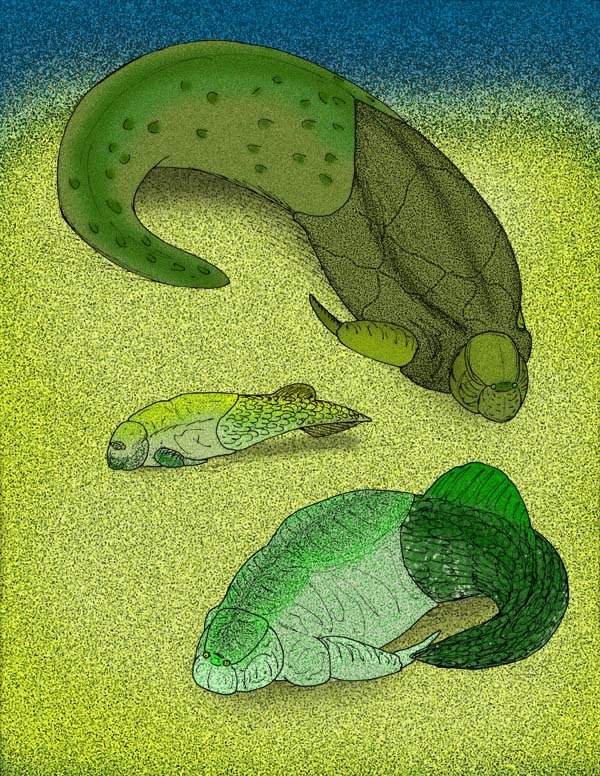Antiarchs on:
[Wikipedia]
[Google]
[Amazon]
Antiarchi ("opposite anus") is an

Review of Antiarcha at Paleos
{{Taxonbar, from=Q150593 Placoderm orders Articles which contain graphical timelines Taxa named by Edward Drinker Cope
order
Order, ORDER or Orders may refer to:
* A socio-political or established or existing order, e.g. World order, Ancien Regime, Pax Britannica
* Categorization, the process in which ideas and objects are recognized, differentiated, and understood
...
of heavily armored placoderm
Placoderms (from Ancient Greek πλάξ 'plax'', ''plakos'''Plate (animal anatomy), plate' and δέρμα 'derma'''skin') are vertebrate animals of the class (biology), class Placodermi, an extinct group of prehistoric fish known from Pal ...
s. The antiarchs form the second-most successful group of placoderms after the arthrodire
Arthrodira (Greek for "jointed neck") is an Order (biology), order of extinct armored, jawed fishes of the class Placodermi that flourished in the Devonian period before their sudden extinction, surviving for about 50 million years and penetratin ...
s in terms of numbers of species and range of environments. The order's name was coined by Edward Drinker Cope
Edward Drinker Cope (July 28, 1840 – April 12, 1897) was an American zoologist, paleontology, paleontologist, comparative anatomy, comparative anatomist, herpetology, herpetologist, and ichthyology, ichthyologist. Born to a wealthy Quaker fam ...
, who, when examining some fossils that he thought were armored tunicate
Tunicates are marine invertebrates belonging to the subphylum Tunicata ( ). This grouping is part of the Chordata, a phylum which includes all animals with dorsal nerve cords and notochords (including vertebrates). The subphylum was at one time ...
s related to '' Chelyosoma'', mistakenly thought that the orbital fenestra (i.e., the hole in the headshield for the eyes, nose and pineal foramen) was the opening for the mouth, or oral siphon, and that the opening for the anal siphon was on the other side of the body, as opposed to having both oral and anal siphons together at one end.
The front portions of their bodies were heavily armored, to the point of literally resembling a box with eyes, with the sometimes scaled, sometimes naked rear portions often becoming sinuous
Sinuosity, sinuosity index, or sinuosity coefficient of a continuously differentiable curve having at least one inflection point is the ratio of the curvilinear length (along the curve) and the Euclidean distance ( straight line) between the ...
, particularly with later forms. The pair of pectoral fins
Fins are moving appendages protruding from the body of fish that interact with water to generate thrust and help the fish swim. Apart from the tail or caudal fin, fish fins have no direct connection with the back bone and are supported only b ...
were modified into a pair of caliper
Calipers or callipers are an instrument used to measure the linear dimensions of an object or hole; namely, the length, width, thickness, diameter or depth of an object or hole. The word "caliper" comes from a corrupt form of caliber.
Many ty ...
-like, or arthropod
Arthropods ( ) are invertebrates in the phylum Arthropoda. They possess an arthropod exoskeleton, exoskeleton with a cuticle made of chitin, often Mineralization (biology), mineralised with calcium carbonate, a body with differentiated (Metam ...
-like limbs. In primitive forms, such as '' Yunnanolepis'', the limbs were thick and short, while in advanced forms, such as ''Bothriolepis
''Bothriolepis'' (from , 'trench' and 'scale') was a widespread, abundant and diverse genus of antiarch placoderms that lived during the Middle to Late Devonian period of the Paleozoic Era.
Historically, ''Bothriolepis'' resided in an array ...
'', the limbs were long and had elbow-like joints. The function of the limbs are still not perfectly understood, but, most hypothesize that they helped their owners pull themselves across the substrate, as well as allow their owners to bury themselves into the substrate.
Antiarchi, along with ''Brindabellaspis
''Brindabellaspis stensioi'' ("Erik Stensiö's Brindabella Ranges Shield") is a placoderm with a flat, platypus-like snout from the Early Devonian of the Taemas-Wee Jasper reef in Australia. When it was first discovered in 1980, it was originall ...
'', form some of the most basal clades of the Placodermi, or Gnathostomata. They are more related to other placoderms and the more derived jawed fish than the Cephalaspidomorphi
Cephalaspidomorphi (alternatively called Monirhina, or simply cephalaspids) is a Class (biology), class of agnatha, jawless fishes that is presently regarded as uniting the Osteostraci, osteostracans, Galeaspida, galeaspids and Pituriaspida, pituri ...
.
Phylogeny
Below is acladogram
A cladogram (from Greek language, Greek ''clados'' "branch" and ''gramma'' "character") is a diagram used in cladistics to show relations among organisms. A cladogram is not, however, an Phylogenetic tree, evolutionary tree because it does not s ...
from Jia ''et al.'' (2010):

References
*Long, John A. The Rise of Fishes: 500 Million Years of Evolution Baltimore: The Johns Hopkins University Press, 1996. *External links
Review of Antiarcha at Paleos
{{Taxonbar, from=Q150593 Placoderm orders Articles which contain graphical timelines Taxa named by Edward Drinker Cope